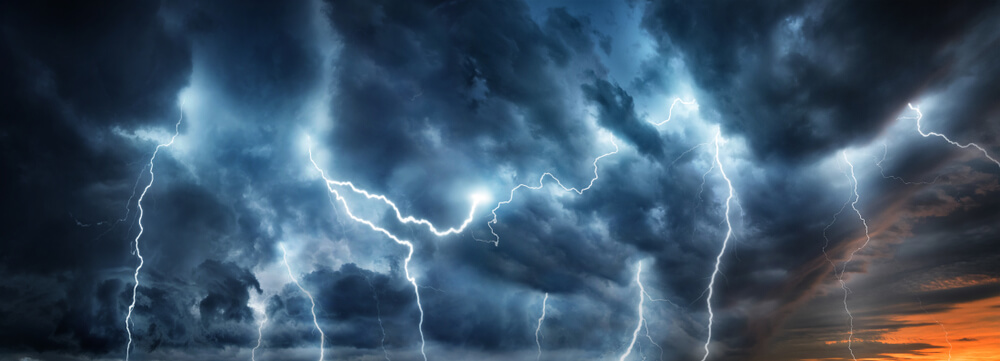Mega lightning flash in the United States covered the territory of three states: this is the official world record
The World Meteorological Organization (WMO) has set two new world records for mega-lightning flashes, including one for the longest single flash distance in North America and one for the longest in South America, reports CNN.

Photo: Shutterstock
“A megaflare is a really big flash of lightning,” said Randall Cerveny, WMO rapporteur on weather and climate extremes. - Most lightning flashes during a storm only travel a few kilometers or so. A megaflare can spread over hundreds of kilometers!
The official definition of a megaflare is any horizontal lightning that travels more than 100 kilometers.
A new record outbreak has gone far beyond the definition.
The new record for the longest single outburst spanned a horizontal distance of about 768 kilometers from Texas to Louisiana, Cerveny said. She surpassed the previous record by 60 kilometers.
On the subject: Scientists have found out how much money you need for happiness: the amount came out less than you think
While it broke the record for longest distance, it did not break the longest record, which came with another South American megaflare lasting over 17 seconds, setting a new record for longest duration. This mega-flare lasted about 17,102 seconds, surpassing the previous record by just 0,37 seconds.
“These are extraordinary records of individual lightning flashes,” Cerveny says.
Detection of megaflares from space
Previously, the duration and magnitude of lightning flashes have been documented using Lightning Mapping Array (LMA) terrestrial networks. However, scientists have found that the technology can only detect lightning up to a certain magnitude.
Scientists decided to find a way to look at lightning from top to bottom.
With new advances in technology, lightning scientists have been able to use Geostationary Lightning Mappers (GLMs) on space-orbiting satellites to collect larger-scale lightning data, such as new records of mega-lightning flashes.
The new technology opens a window into an aspect of the weather that was previously out of reach. Michael J. Peterson of the Space and Remote Sensing Group at Los Alamos National Laboratory said: "Now we have new capabilities that help measure and capture many aspects of lightning and study the amazing nuances of its behavior."
As technology continues to advance, experts in the field are optimistic about lightning detection on an even larger scale in the future. Randall Cerveny said: "It is likely that there are still large extreme events, and that we can observe them as technology improves."
“But these results are also important to the general public as a stark reminder that lightning can strike far from the source area,” Cerveny said.
Do you hear the thunder? This is what you should do next
With the approach of the severe weather season in the United States, the threat of lightning to the public is a serious danger.
“Lightning is a serious hazard that claims many lives every year,” explained Professor Petteri Taalas, WMO Secretary-General. — The research results highlight important public safety issues. In electrified clouds, flashes can travel extremely long distances."
Places such as the Great Plains in the United States and the La Plata Basin in South America are particularly vulnerable to the types of thunderstorms that produce mega-flares.
Lightning experts are urging people living in areas prone to severe weather to be aware of lightning-safe locations in the event of a major storm.
Lightning specialist Ron Holle explained: “The only places safe for lightning are solid buildings with electrical wiring and plumbing, not structures like the beach or bus stop.” If you are not near a lightning protection building, you can take shelter inside an enclosed vehicle with a metal top rather than a buggy or motorcycle.
If you absolutely can't get to shelter during a thunderstorm, do what you can to reduce your risk of being struck by lightning. WikiHow. Here are a few rules of safe behavior if you are in an open area:
- Move to a lower altitude. Lightning is more likely to strike objects located at high altitudes.
- Squat down, legs together, head pressed to chest or between knees, hands covering ears or pressing knees. Do not lie flat on the ground, as this increases the lightning's target. This is a difficult position, and it certainly does not guarantee your safety.
- Avoid large open spaces where you are taller than anything around you, such as a golf course or soccer field.
- Stay away from isolated objects such as trees and lampposts.
- Stay away from unprotected vehicles such as golf carts and unprotected structures such as picnic sheds. Avoid long metal structures such as grandstands.
- If you are in a thunderstorm with a group of people, keep a distance of at least 15,2-30,5 m between each person. This will reduce the risk of lightning being passed from one person to another.
- If you are fishing or swimming, get out of the water immediately and move away from the body of water. During a thunderstorm, being near water is extremely dangerous.
- Wear rubber boots. They are made from a material that is a poor conductor of electricity.
- If you're hiking with a metal-frame backpack, take it off as soon as you see the zipper. Be sure to leave it at least 30,5 m away from where you are hiding.
You may be interested in: top New York news, stories of our immigrants and helpful tips about life in the Big Apple - read it all on ForumDaily New York.
Staying indoors is often the safest way to avoid being struck by lightning; however, if lightning strikes directly into a building or power line, you can still get electrocuted if you touch any object that conducts electricity. To protect yourself from indoor lightning, you should avoid certain activities that can result in electrical shock and any other fatal injury.
- Avoid using any plumbing during thunderstorms. If lightning strikes your home, building, or other nearby locations, it can transfer an electrical charge to the metal pipes in the plumbing, which can cause electric shock if you use plumbing connected to those pipes. Do not shower or bathe, or use sinks or faucets during thunderstorms.
- Do not use a wired landline phone during a thunderstorm. If lightning strikes a main telephone line in your area or outside your home, the electricity from the strike will travel through every phone connected to the line and electrocute anyone using the phone.
- Do not stand on surfaces that have moisture or water during a thunderstorm. Electrical currents will pass through the ground where water is present and can kill anyone who comes into contact with those surfaces. Examples of surfaces to avoid are basements, patios, garage floors, and other floors where water and other moisture may be present.
- Do not use electrical appliances connected to the outlet during thunderstorms. Use cordless or battery powered devices during thunderstorms to avoid electric shock.
Read also on ForumDaily:
How to Get a Talented O1 Visa: USCIS Releases New Requirements
On a rainy day: who are the preppers and what can they teach during a pandemic
Subscribe to ForumDaily on Google NewsDo you want more important and interesting news about life in the USA and immigration to America? — support us donate! Also subscribe to our page Facebook. Select the “Priority in display” option and read us first. Also, don't forget to subscribe to our РєР ° РЅР ° Р »РІ Telegram and Instagram- there is a lot of interesting things there. And join thousands of readers ForumDaily New York — there you will find a lot of interesting and positive information about life in the metropolis.











